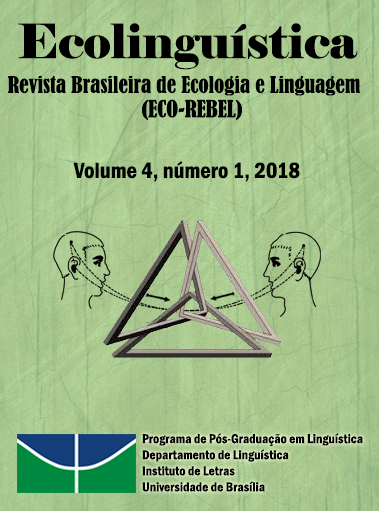Ecossistema cultural
Keywords:
Ecolinguistics; Ecosystemic Linguisticas; Linguistic Ecosystem; Cultural Ecosystem.Abstract
The objective of this article is to take up the relationships between language and culture, showing that the former is part of the latter, and that both of them are part of an ecosystem, linguistic ecosystem and culural ecosystem, respectively. In view of the fact that culture also has a semiotic character, it follows that its components (material and immaterial) may be used in the acts of communicative interaction that are part of the version of ecolinguistics called ecosystemic linguistics. This is so named because its starting point is biological ecosystem. For this reason, it gives us the tools for the study any language phenomena from the ecological point of view, a holistic view. Finally, it is claimed that a knowledge of at least part of the culture related to a second language one is going to learn is indispensable, in order not to make a faux pas when talking to locals.
References
BANG, Jørgen Chr.; DØØR, Jørgen. Ecolinguística: um enquadramento conceitual. Ecolinguística: revista brasileira de ecologia e linguagem (ECO-REBEL) v. 1, n. 2, 2015, p. 65-81. Disponível em: http://periodicos.unb.br/index.php/erbel/article/view/16527/11770 (acesso: 01/11/2015).
BOOKCHIN, Murray. What is social ecology? In: Zimmermann, M. E. (org.). Environmental Philosophy: From Animal Rights to Radical Ecology. Englewood Cliffs, NJ: Prentice Hall, 1993.
CAPRA, Fritjof. Sabedoria incomum. São Paulo: Cultrix, 1995, 10ed.
COUTO, Hildo Honório do. 1981. Semiótica da cultura e tradução. In: Mattos, Delton de (org.). Estudos de tradutologia I. Brasília: Kontakt, p. 9-32.
_______. Anticrioulo: manifestação linguística de resistência cultural. Brasília: Thesaurus, 2002.
_______. Linguística ecossistêmica. Ecolinguística: Revista Brasileira de Ecologia e Linguagem ECO-REBEL, v. 01, n. 01, 2015, p. 47-81. Disponível em: http://periodicos.unb.br/index.php/erbel/article/view/15135/10836 (10/12/2015)
_______. Estudos gramaticais à luz da linguística ecossistêmica. Scripta v. 20, n. 38, 2016a, p. 26-53. Disponível em (20/11/2016): http://periodicos.pucminas.br/index.php/scripta/article/view/P.2358-3428.2016v20n38p26
_______. Comunidade de fala revisitada. Disponível em: http://periodicos.unb.br/index.php/erbel/article/view/20035, 2016b (acesso: 20/12/2016).
_______. Contato interlinguístico: da interação à gramática, 2017a. Disponível em:
http://www.ecoling.unb.br/images/contato-interlinguistico.pdf (acesso: 20/10/2017), 2ª ed. (1ª ed., 1999).
_______. Linguística ecossistêmica: um novo modo de estudar os fenômenos da linguagem. In: COUTO, Elza; DOURADO, Zilda; SILVA, Anderson; AVELAR FILHO, João (orgs.). Linguística ecossistêmica: 10 anos de ecolinguística no Brasil. Campinas: Pontes, 2017b, p. 21-43.
_______; COUTO, Elza; BORGES, Lorena. Análise do discurso ecológica (ADE). Campinas: Pontes, 2015.
ECO, Umberto. A estrutura ausente. São Paulo: Perspectiva, 1974.
FINKE, Peter. Identity and manifoldness: New perspectives in science, language and politics. In: FILL, Alwin & Peter MÜHLHÄUSLER (orgs.). The ecolinguistics reader. Londres: Continuum, 2001, p. 84-90.
GAIO, Mario Luis Monachesi. Etnicidade linguística em movimento: os processos de transculturalidade revelados nos brasileirítalos do eixo Rio de Janeiro-Juiz de Fora. Niterói: Universidade Federal Fluminense, Tese de Doutorado, 2017, 318p.
HAUGEN, Einar. The ecology of language. Stanford: Stanford University Press, 1972, p. 325-339. Também em COUTO ET AL. O paradigma ecológico para as ciências da linguagem. Goiânia: Editora da UFG, 2016, p. 57-75.
LAMB, Sydney M. Neuro-cognitive structure in the interplay of language and thought. In: PÜTZ, Martin; VESPOOR, Marjolijn H. (orgs.) Explorations in linguistic relativity. Amsterdam: Benjamins, 2000, p. 173-196.
MUFWENE, Salikoko. The ecology of language evolution. Cambridge: Cambridge University Press, 2001.
NEVES, Walter. Antropologia ecológica. São Paulo: Cortez Editora, 1996.
PEIRCE, Charles Sanders. Semiótica e filosofia. São Paulo: Cultrix, 1972.
PREZIOSI, Donald. Toward a relational theory of of culture. In: The Third LACUS Forum. Columbia, S.C.: Hornbeam Press, 1977, p. 278-286.
STAGL, Justin. Kulturanthropologie und Gesellschaft. Munique: List Verlag, 1974.
TRAMPE, Wilhelm. Ökologische Linguistik und Humanökologie. In: FILL, Alwin; Hermine PENZ & Wilhelm TRAMPE (orgs.). Colourful green ideas. Berna: Peter Lang, 2002, p. 89-101.
Downloads
Published
Issue
Section
License
Authors who publish in this journal agree to the following terms:
Authors retain copyright and grant the journal the right of first publication. The work is simultaneously licensed under the Creative Commons Attribution License allowing the sharing of the work with acknowledgment of the authorship of the work and initial publication in this journal.
Authors are authorized to enter into additional contracts separately for non-exclusive distribution of the version of the work published in this journal (e.g., publishing in institutional repositories or as book chapters), with acknowledgment of authorship and initial publication in this journal.
Authors are allowed and encouraged to post and distribute their work online (e.g., in institutional repositories or on their personal page) at any point before or during the editorial process, as this can bring about productive revisions as well as increase impact.
Citation of published works (See The Effect of Free Access).



3.png)



